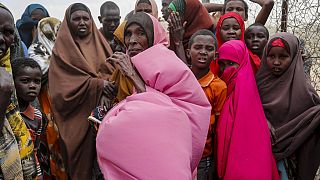Environment
Wilfran Moufouma Okia from the World Meteorological Organization (WMO), the U.N. weather agency, says "La Nina is a world phenomenon, a natural one, which is normally characterized by a large-scale cooling at the surface of the ocean in the equatorial Pacific. Now, the implication of La Nina being that it changes the circulation in the ocean -- A; B it changes the weather pattern worldwide with the implication on the society, human and people."
The WMO says La Nina conditions have strengthened in the eastern and central equatorial Pacific with an increase in trade winds in recent weeks.
This could mean that for the third year in a row the phenomenon known as La Nina is poised to last through the end of this year, a mysterious "triple dip" — the first this century.
The agency cautions that the "triple dip" doesn't mean global warming is easing.
"Since 1950, this is the first time we have had three La Ninas in a row. But we need to caution this a bit. When we say 'three La Ninas in a row' -- So we started in 2020, August-September, we had one episode; A year later, another episode. And this time it's a third episode. But in between, the intensity has changed. So it's not a persistent three La Ninas throughout, but in the three different years we have La Nina -- and that's unusual," says Okia.
Floods, droughts and extreme weather are all examples of the impacts of La Nina conditions, which involve a large-scale cooling of ocean surface temperatures.Despite La Nina being a cooling cycle, it still is impacted by climate change adds Okia:
"In the background we have the climate change, the rise of temperature, and the system is changing. Just one -- last year, the Intergovernmental Panel on Climate Change, which is the IPCC, indicated a couple of things on La Nina. In the future moving forward with a global warming, La Nina and Nino will remain a dominant factor in the year-to year-evolution of the climate system -- that's one. The rainfall variability, which is a rainfall associated with the La Nina behavior will amplify, so which means we will have variation of La Nina and El Nino throughout the century."
La Nina has different impacts around the region says Okia:
"When you have La Nina, West Africa -- an area going from Senegal to Sudan -- normally is struck by floods; East Africa by drought; Australia, Indonesia with floods, and so forth. So knowing the evolution of La Nina helps us anticipate."
At least 1 million people in Somalia have been displaced by the worst drought in decades, driven by climate change, that also affects the wider Horn of Africa including Ethiopia and Kenya.
"One of the regions mostly affected by La Nina is East Africa, where we had a long drought. We've also seen places like California with the drought and Australia with floods," he adds.
La Nina often leads to more Atlantic hurricanes, less rain and more wildfires in the western United States, and agricultural losses in the central U.S.
El Nino and La Nina occur every three to seven years with the ocean returning to more normal temperatures in between. El Nino is more frequent than La Nina.
Together El Nino, La Nina and the neutral condition are called ENSO, which stands for El Nino Southern Oscillation, and they have one of the largest natural effects on climate, at times augmenting and other times dampening the big effects of human-caused climate change from the burning of coal, oil and gas, scientists say.
***AFP***










02:05
In Zimbabwe, metal scrap collecting is reducing environmental pollution
01:22
World will have to learn to live with heatwaves, UN says
01:15
Morocco says 2024 was the hottest year with temperatures reaching 47.7 degrees
00:24
Greenland and Iceland saw record heat in May
01:30
Macron sparks global push to protect oceans
01:06
Experts warn of an increase in Glacier-related risks from climate change